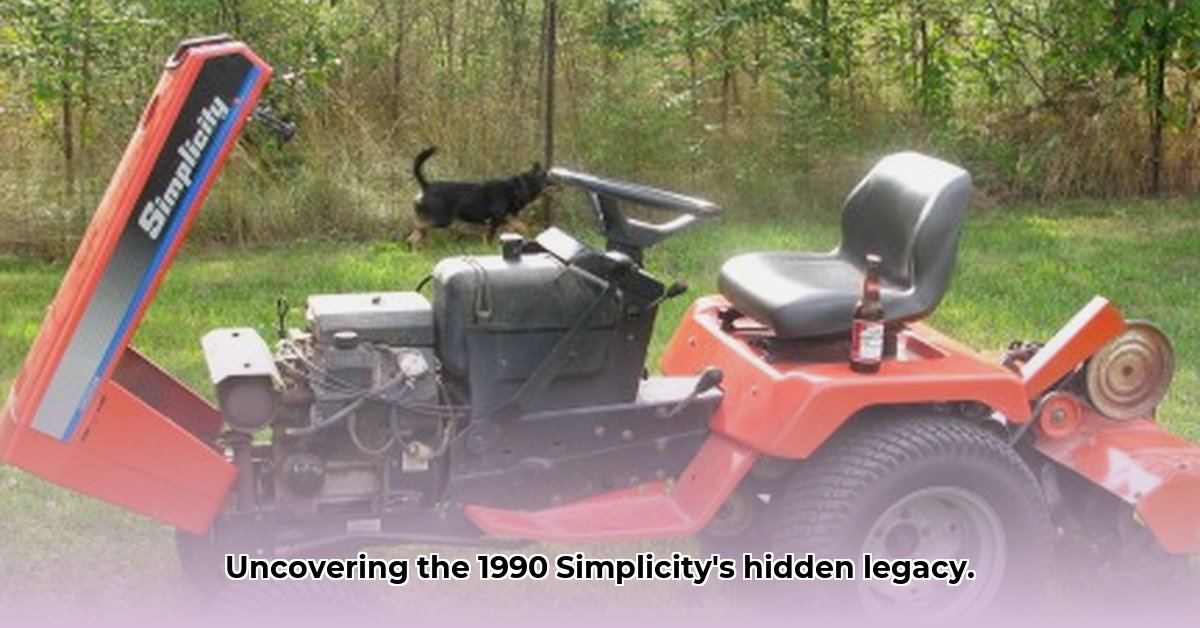
Simplicity's Past: A Legacy of Dependability
The Simplicity Manufacturing Company, a name synonymous with dependable lawn and garden equipment, has a long and storied history. Early Simplicity tractors, reflecting the technology and manufacturing practices of their era, often employed simpler designs, less powerful engines, and materials that might appear less sustainable by today's standards. However, as technology advanced, so did Simplicity's offerings. More powerful engines, refined designs, and alterations in materials became hallmarks of later models. But did these improvements inherently translate to a smaller environmental footprint? This question is central to our examination of the 1990 Simplicity lawn tractor and its broader legacy. For more on vintage Simplicity tractors, check out this resource.
The 1990 Simplicity: A Workhorse of Its Time
The 1990 Simplicity lawn tractor holds a unique place in the company's history. While precise emission data for this specific model remains elusive—a crucial limitation we will address—its well-earned reputation for durability offers a compelling starting point for a sustainability assessment. Anecdotal evidence from long-term owners consistently points to decades of reliable service from these machines. This longevity suggests an inherent level of environmental responsibility. After all, a product that lasts longer requires fewer replacements, thereby reducing the overall environmental impact, right? Though a promising lead, this alone doesn’t provide a complete picture.
Assessing Sustainability: Navigating the Data Gap
A precise calculation of the 1990 Simplicity's environmental impact proves immensely challenging. Critical data remains unavailable, making a comprehensive sustainability assessment difficult. We lack precise information on fuel efficiency, manufacturing emissions, and the environmental costs associated with disposal. This absence significantly restricts the accuracy of any conclusion. It's akin to solving an equation with missing variables—the solution remains elusive.
To fully understand this tractor's impact, we need concrete data. What was the total carbon footprint of its production, including raw material sourcing and manufacturing processes? What was its fuel consumption relative to modern counterparts? Without this, our conclusions remain educated estimations, not definitive statements.
Despite these limitations, the considerable lifespan of many 1990 Simplicity tractors, often exceeding that of modern models, hints at potential environmental benefits. The ability to repair and reuse a machine for extended periods might offset some negative impacts arising from the use of a gasoline engine. This is a noteworthy proposition, but without complete data, confirmation remains impossible.
The Path Forward: A Collaborative Research Effort
To shed light on the environmental legacy of the 1990 Simplicity, and similar vintage equipment, a multifaceted approach is needed:
Comprehensive Data Collection: Researchers must systematically collect data on fuel usage, emissions, and manufacturing processes for various Simplicity models. Life cycle assessments (LCAs), which trace a product's environmental impact from production to disposal, are essential.
Industry Transparency: We must encourage manufacturers to be more transparent about the environmental details of their products. Open data sharing is crucial for accurate assessment and informed decision-making.
Comparative Analysis: Once sufficient data is available, we can compare the LCAs of the 1990 Simplicity with modern equivalents. This will reveal whether its durability translates to an overall sustainability advantage. Is it truly “greener” than its successors despite its older technology? The answer lies in gathering the necessary data.
Shared Responsibility: Stakeholders' Roles in Sustainable Practices
Creating a sustainable future for all lawn care equipment demands a collaborative effort. We must place responsibility on multiple stakeholders:
| Stakeholder | Short-Term Actions | Long-Term Actions |
|---|---|---|
| Researchers/Academics | Conduct LCAs on vintage and modern equipment; publish findings openly. | Develop standardized LCA frameworks for agricultural machinery; promote data sharing and collaborative research. |
| Environmental NGOs | Advocate for data transparency and policies promoting responsible disposal. | Promote circular economy models for end-of-life equipment; raise consumer awareness of sustainable practices. |
| Museums/Collectors | Preserve vintage tractors for research & education. | Create exhibits highlighting sustainable design and manufacturing practices in agricultural equipment history. |
| Manufacturers | Increase use of sustainable materials; improve production processes; share data openly. | Invest in R&D for environmentally friendly products; prioritize transparency and accountability. |
The 1990 Simplicity lawn tractor is more than just a machine; it's a historical artifact. Studying its environmental impact provides invaluable insights into sustainable design and use. Moving toward a green future requires a complete understanding of the past.
Key Takeaways: A Call for Further Research
- Vintage Simplicity tractors, while built to last, present a complex environmental picture. Their durability is an asset, but their fuel efficiency and likely emissions are lower than modern equivalents.
- Accurate environmental impact assessment requires more data, much of which is currently unavailable, preventing definitive conclusions about their sustainability.
- Responsible restoration and maintenance practices can mitigate some negative environmental effects.
- Further research is urgently needed, particularly to quantify emissions and fuel consumption rates for accurate assessment.